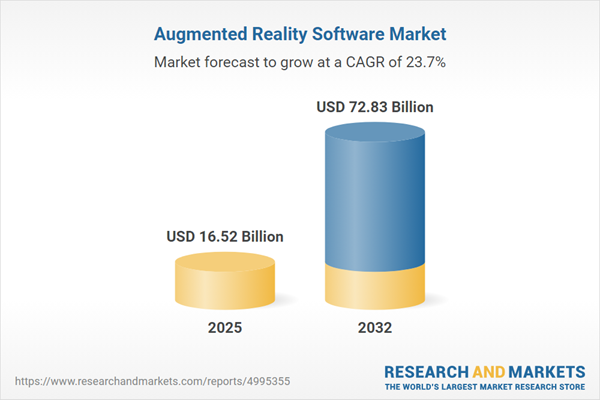Speak directly to the analyst to clarify any post sales queries you may have.
The augmented reality software market is redefining digital engagement for enterprises and consumers alike, with scalable solutions now driving transformation across workflows, training, and customer experiences. As businesses adapt to increasingly immersive environments, understanding the evolving landscape of AR software is vital for strategic growth.
Market Snapshot: Augmented Reality Software Market
The Augmented Reality Software Market grew from USD 13.30 billion in 2024 to USD 16.52 billion in 2025. It is expected to continue growing at a CAGR of 23.67%, reaching USD 72.83 billion by 2032.
This rapid trajectory reflects expanding enterprise deployments and a growing focus on digital transformation across industries, supported by continuous advancements in core technologies powering AR experiences. Senior executives are now recognizing AR as a critical component in future-proofing operations, unlocking value through improved efficiency and interactive collaboration.Scope & Segmentation
This comprehensive research covers diverse market segments, device types, deployment models, and key geographies to provide essential data and strategic guidance to decision-makers.
- Component: AR displays, AR headsets, sensors & cameras, smart glasses, consulting, implementation services, maintenance & support, AR analytics, AR content management, AR development platforms, AR tools.
- Industry Vertical: Automotive & transportation, defense & aerospace, education, healthcare (medical training, patient care, surgical assistance), manufacturing (design & prototyping, maintenance & repair, training), retail (customer engagement, inventory management, visual merchandising).
- Device Type: Handheld devices, head mounted displays, spatial AR displays.
- Deployment Mode: Cloud, on-premise.
- Geographies: Americas (North America, Latin America), Europe, Middle East & Africa, Asia-Pacific (including leading and emerging AR markets).
- Company Coverage: Unity Technologies, Apple, Google, PTC, Microsoft, Niantic, Snap, Wikitude, Zappar, Magic Leap.
Key Takeaways for Strategic Decision-Makers
- Enterprises across sectors are transitioning from pilot AR projects to full-scale integration, embedding AR into business operations to enhance productivity and optimize maintenance, training, and customer-facing applications.
- AR software solutions increasingly leverage artificial intelligence and cloud computing, enabling smarter content delivery, robust analytics, and more context-aware, scalable deployments tailored for industry-specific requirements.
- The rise of portable AR hardware, coupled with advanced software frameworks, is reshaping end-user interaction and facilitating smoother migration into both consumer and industrial environments.
- Regional adoption patterns reveal strong uptake in Asia-Pacific manufacturing and retail, while North America and Europe emphasize compliance-driven deployments, especially in healthcare and defense applications.
- Competitive dynamics are fueled by both established technology leaders building comprehensive platforms and specialized startups innovating in areas such as spatial mapping and real-time object recognition, offering modular and flexible architectures to support varying enterprise needs.
Tariff Impact: United States Measures and Supply Chain Dynamics
Recent United States tariff measures are introducing significant supply chain challenges for AR device and component manufacturers. Increased costs of semiconductors, optical elements, and display modules are pressuring margins and prompting a shift toward alternative sourcing and localized manufacturing strategies. Service providers face elevated project delivery costs due to disrupted cross-border logistics, while supply chain diversification is emerging as a key resilience tactic within the industry. Although AR software platforms remain largely insulated from direct tariff effects, adoption rates may be influenced by rising hardware costs, especially for organizations considering large-scale deployments.
Methodology & Data Sources
This report applies a blend of primary interviews with industry executives and end-users, and secondary research including regulatory reviews, industry reports, and patent analyses. Quantitative modeling is supported by proprietary databases, while qualitative insights are validated by market experts and scenario-based impact assessments.
Why This Report Matters
- Empowers senior leaders to make informed investment decisions with comprehensive segmentation and regional intelligence.
- Enables benchmarking against industry peers and identification of emerging technology trends critical for future competitiveness.
- Provides actionable recommendations on navigating complex supply chains, regulatory shifts, and evolving software ecosystems in the AR landscape.
Conclusion
AR software is rapidly becoming a foundation for immersive enterprise innovation and consumer engagement globally. Strategic adoption, supported by agile frameworks and cross-industry collaboration, will be key to capturing the next wave of digital value creation in this dynamic market.
Additional Product Information:
- Purchase of this report includes 1 year online access with quarterly updates.
- This report can be updated on request. Please contact our Customer Experience team using the Ask a Question widget on our website.
Table of Contents
3. Executive Summary
4. Market Overview
7. Cumulative Impact of Artificial Intelligence 2025
Companies Mentioned
The companies profiled in this Augmented Reality Software market report include:- Unity Technologies, Inc.
- Apple Inc.
- Google LLC
- PTC Inc.
- Microsoft Corporation
- Niantic, Inc.
- Snap Inc.
- Wikitude GmbH
- Zappar Limited
- Magic Leap, Inc.
Table Information
| Report Attribute | Details |
|---|---|
| No. of Pages | 188 |
| Published | October 2025 |
| Forecast Period | 2025 - 2032 |
| Estimated Market Value ( USD | $ 16.52 Billion |
| Forecasted Market Value ( USD | $ 72.83 Billion |
| Compound Annual Growth Rate | 23.6% |
| Regions Covered | Global |
| No. of Companies Mentioned | 11 |









